i) Hydrogen ions (H+)
ii) Blue solution turns colourless and brown solid is deposited. This is because zinc displaces copper
(II) ions from solution forming copper metal
iii) The reaction leads to formation of insoluble calcium sulphate which coats the calcium metal
preventing further action of the acid on the metal
iv) It is used in hospitals to immobilize broken limbs
b) Dissolves solid chloride in water to obtain a solution. Separately dissolve lead (II) nitrate and mix
the two solutions to precipitate lead (II) chloride. Filter to obtain lead (II) chloride as residue. Wash the solid and dry between filter papers.
c) i) It does not react with chlorine.
ii) Concentrated sulphuric (VI) acid.
johnmulu answered the question on April 10, 2017 at 11:24
- The diagram below illustrates a method of preparing salts by direct synthesis.(Solved)
The diagram below illustrates a method of preparing salts by direct synthesis.
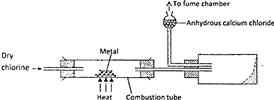
a) This method can be used to prepare either aluminium chloride or iron (III) chloride. Explain why it cannot be used to prepare sodium chloride.
b) Describe how a sample of sodium can be prepared in the laboratory by direct synthesis.
Date posted: April 10, 2017. Answers (1)
- a) Write an equation to show the effect of heart on the nitrate of:(Solved)
a) Write an equation to show the effect of heart on the nitrate of:
i) Potassium ii) Silver
b) The table below gives information about elements A1, A2, A3, and A4
i) In which period of the periodic table is element A2? Give reason
ii) Explain why the atomic radius of: I. A1 is greater than that of A2;
II. A4 is smaller than its ionic radius

iii) Select the element which is in the same group as A3
Date posted: April 10, 2017. Answers (1)
- Study the flow chart below and answer the question that follows(Solved)
Study the flow chart below and answer the question that follows
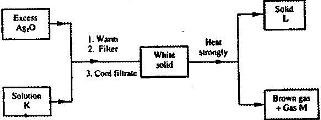
Identify
a) Solution K
b) Solid L
c) Gas M
Date posted: April 10, 2017. Answers (1)
- Use the scheme below to answer the questions that follow.(Solved)
Use the scheme below to answer the questions that follow.

a) Identify the solids H and J
b) State one commercial use of solid J.
Date posted: April 10, 2017. Answers (1)
- The set-up below was used to prepare anhydrous chlorides of elements in laboratory where no fume cupboard was available. The chlorides were to be collected in flask 1.(Solved)
The set-up below was used to prepare anhydrous chlorides of elements in laboratory where no fume cupboard was available. The chlorides were to be collected in flask 1.
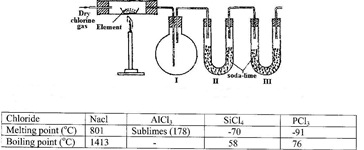
The following table shows the melting and boiling points of the chlorides that were prepared.
a) Explain why it is necessary to pass dry chlorine through the apparatus before heating each element.
b) Give two reasons why tubes II and III were filled with soda lime (solid mixture of sodium hydroxide and calcium hydroxide)
c) Explain why it would not be possible to collect any sodium chloride in flask 1
d) Name one other substance that can be used in tubes II and III
e) Write an equation for the reaction that forms phosphorous (III) chloride
f) Describe how you would separate a mixture of sodium chloride and aluminium chloride
Date posted: April 10, 2017. Answers (1)
- The grid below is part of the periodic table. Use it to answer the questions that follow. (The letters are not the actual symbols of the elements).(Solved)
The grid below is part of the periodic table. Use it to answer the questions that follow. (The letters are not the actual symbols of the elements).

a) Which is the most reactive non-metallic element shown
b) (i) Write the formula of the compound formed when element A
ii) Name the bond type in the compound formed in b (i) above.
c) i) What is the name given to the group of elements where C, G and H belong?
ii) Write the equation for the reaction that occurs when C in gaseous form is passed through a solution containing ions of element H.
d) The melting points of elements F and G are 1410oC and -101oC respectively. In terms of structure and bonding, explain why there is a large difference in the melting points of F and G.
e) D forms two oxides. Write the formula of each of the two oxides.
Date posted: April 10, 2017. Answers (1)
- a) Other than their location in the atom, name two other differences between an electron and a proton.
b) The table below gives the number of electrons, protons and neutrons in particles
A, B, C, D, E, F and G.
(Solved)
a) Other than their location in the atom, name two other differences between an electron and a proton.
b) The table below gives the number of electrons, protons and neutrons in particles
A, B, C, D, E, F and G.
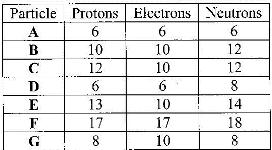
i) Which particle is likely to be a halogen?
ii) What is the mass number of E?
iii) Write a formula of the compound formed when E combines with G.
iv) Name the type of bond formed in (iii) above.
v) How does the radii of C and E compare? Give a reason.
vi) Draw a dot (.) and cross (x) diagram for the compound formed between A and F
vii) Why would particle B not react with particle D?
Date posted: April 10, 2017. Answers (1)
- The diagram below shows the bonding between aluminium chloride and ammonia.(Solved)
The diagram below shows the bonding between aluminium chloride and ammonia.
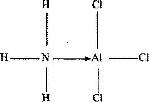
a) Name the types of bonds that exists in the molecule
b) How many electrons are used for bonding in the molecule?
Date posted: April 10, 2017. Answers (1)
- The boiling point of some compounds of hydrogen with some elements in groups 4 and 6 of the periodic table are given below.(Solved)
The boiling point of some compounds of hydrogen with some elements in groups 4 and 6 of the periodic table are given below.

a) Which of the compounds CH4 and SiH4 has stronger intermolecular forces?
b) Explain why the boiling points of H2O and H2S show different trends from that of CH4 and SiH4
Date posted: April 10, 2017. Answers (1)
- The table below gives atomic numbers of elements represented by the letters A, B, C and D.(Solved)
The table below gives atomic numbers of elements represented by the letters A, B, C and D.

Use the information to answer the questions that follow.
a) Name the type of bonding that exists in the compound formed when A and D react.
b) Select the letter which represents the best oxidizing agent. Give a reason for your answer.
Date posted: April 10, 2017. Answers (1)
- The diagram below is a section of a model of the structure of element T.(Solved)
The diagram below is a section of a model of the structure of element T.

a) State the type of bonding that exists in T.
b) In which group of the periodic table does element T belong? Give a reason.
Date posted: April 10, 2017. Answers (1)
- The table below gives some information about the electrical conductivity and the likely bonding in substances N, P and Q. Complete the table by inserting the missing information in the spaces numbered I, II and III.(Solved)
The table below gives some information about the electrical conductivity and the likely bonding in substances N, P and Q. Complete the table by inserting the missing information in the spaces numbered I, II and III.

Date posted: April 10, 2017. Answers (1)
- The table below shows the properties of substances K, L, M and N.(Solved)
The table below shows the properties of substances K, L, M and N.

Date posted: April 10, 2017. Answers (1)
- Study the information in the table below and answer the questions that follow. The letters do not represent the symbols of the elements.(Solved)
Study the information in the table below and answer the questions that follow. The letters do not represent the symbols of the elements.

a) Write the electron arrangement for the ions formed by elements M and Q
b) Select an element which is
i) The most reactive non-metal
ii) A poor conductor of electricity
c) In which period of the periodic table does element R belong?
d) Element R loses its outermost electron more readily than L. Explain
Date posted: April 10, 2017. Answers (1)
- Use the information in the table below to answer the questions that follows.(Solved)
Use the information in the table below to answer the questions that follows.

Explain the trend in the molar heats of vaporization.
Date posted: April 10, 2017. Answers (1)
- Study the information given in the table below and answer the questions that follow.
The letters do not represent the actual symbols of the elements
(Solved)
Study the information given in the table below and answer the questions that follow.
The letters do not represent the actual symbols of the elements
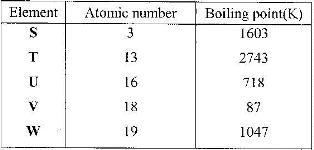
a) Select the elements which belong to the same:
i) Group
ii) Period
b) Which element
i) is in gaseous state at room temperature? Explain. (Take room temperature to be 298K)
ii) Does not form an oxide?
c) Write the
i) Formula of the nitrate of element T.
ii) Equation for the reaction between elements S and U
d) What type of bond would exists in the compound formed when U and T react? Give a reason for your answer
e) The aqueous sulphate of element W was electrolyzed using inert electrodes. Name products formed at the:
i) Cathode
ii) Anode
Date posted: April 10, 2017. Answers (1)
- The table below shows some properties of substances C, D and E. Study it and answer the questions that follow.(Solved)
The table below shows some properties of substances C, D and E. Study it and answer the questions that follow.

Select a substance:
a) With a giant molecular structure.
b) That is not likely to be an element
Date posted: April 10, 2017. Answers (1)
- Study the information below and answer the questions that follow: The letters do not represent the actual symbols of the elements.(Solved)
Study the information below and answer the questions that follow: The letters do not represent the actual symbols of the elements.
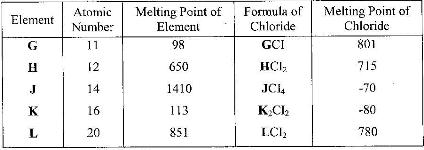
i) Which elements are metals? Give a reason.
ii) Write the formula of the compound formed when element H reacts with elements K.
iii) Explain why the melting point of J is higher than that of K.
iv) What is the oxidation state of J in its chloride.
v) How does the:
I. Melting point of fluoride of G compare with that of its chloride?
II. Reactivity of H and L with water compare? Give an explanation.
Date posted: April 10, 2017. Answers (1)
- The table below shows some properties of substance E, F, G and H(Solved)
The table below shows some properties of substance E, F, G and H

Select the substance that would be most suitable
a) For making a cooking pot
b) As a thermal insulator
Date posted: April 10, 2017. Answers (1)
- The grid below represents part of the periodic table. Study it and answer the questions that follow. The letters are not the actual symbols of the elements.(Solved)
The grid below represents part of the periodic table. Study it and answer the questions that follow. The letters are not the actual symbols of the elements.

i) Select the most reactive metal. Explain.
ii) Select an element that can form an ion with a charge of 3-
iii) Select an alkaline earth metal.
iv) Which group 1 element has the highest first ionization energy? Explain
v) Element A combines with chlorine to form a chloride of A. State the most likely pH value of a solution of a chloride of A. Explain.
Date posted: April 10, 2017. Answers (1)